Business Communication for Managers: Intercultural Communication
VerifiedAdded on 2023/06/11
|9
|2172
|466
Essay
AI Summary
This essay delves into the crucial aspects of business communication for managers, emphasizing the significance of self-awareness and emotional intelligence in leadership. It discusses the importance of understanding one's own emotions and their impact on decision-making, as well as the ability to manage emotions effectively. The essay further explores the dynamics of teamwork, highlighting the differences between groups and teams and the benefits of collaborative problem-solving. It addresses negotiation and conflict management strategies, advocating for open communication, constructive feedback, and collaborative approaches to conflict resolution. Finally, the essay examines intercultural communication, emphasizing the need for positive attitudes, respect for diversity, and active participation in fostering inclusive environments. The paper concludes by stressing the importance of anti-discriminatory policies in promoting effective communication and collaboration within diverse teams.
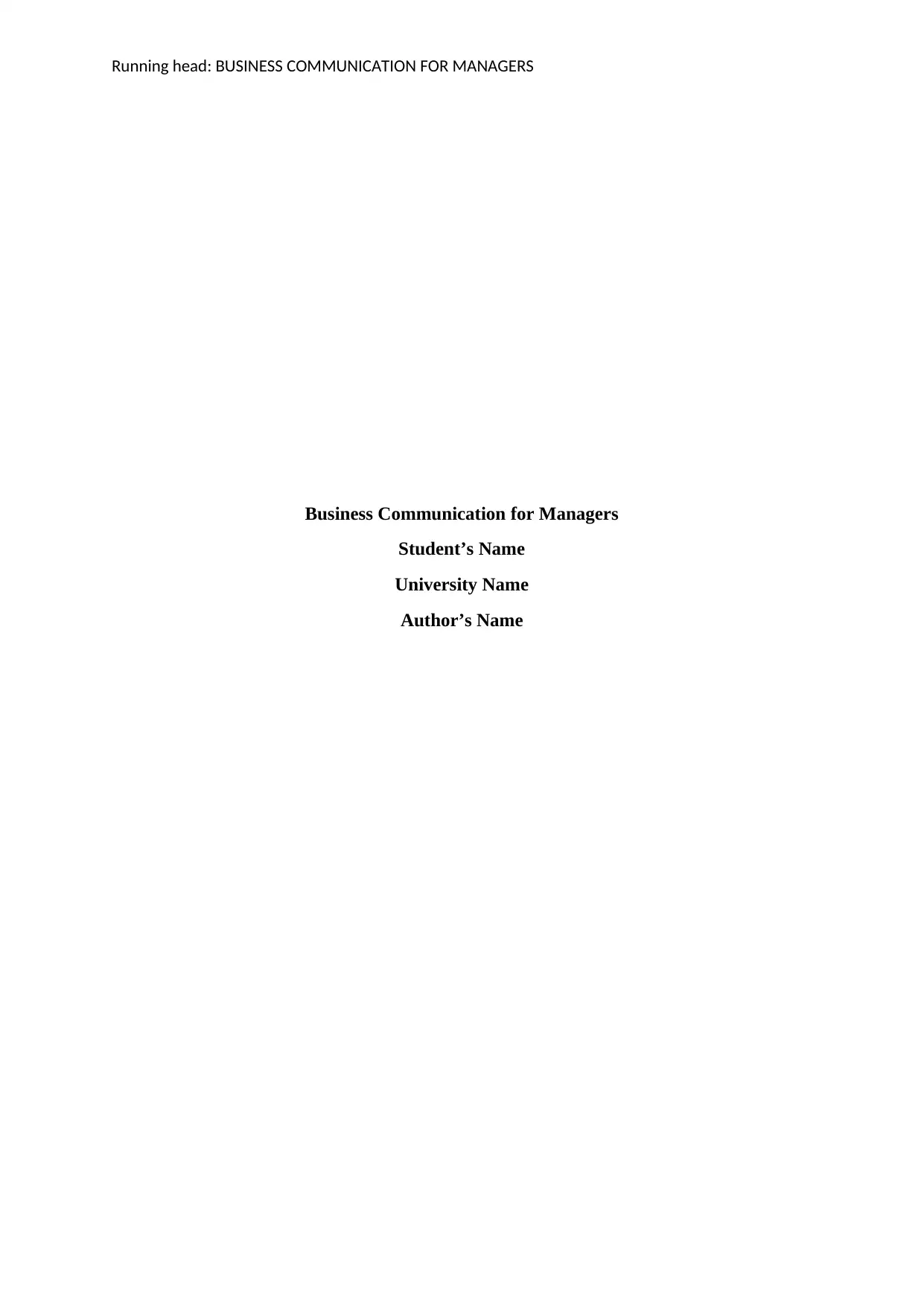
Running head: BUSINESS COMMUNICATION FOR MANAGERS
Business Communication for Managers
Student’s Name
University Name
Author’s Name
Business Communication for Managers
Student’s Name
University Name
Author’s Name
Paraphrase This Document
Need a fresh take? Get an instant paraphrase of this document with our AI Paraphraser
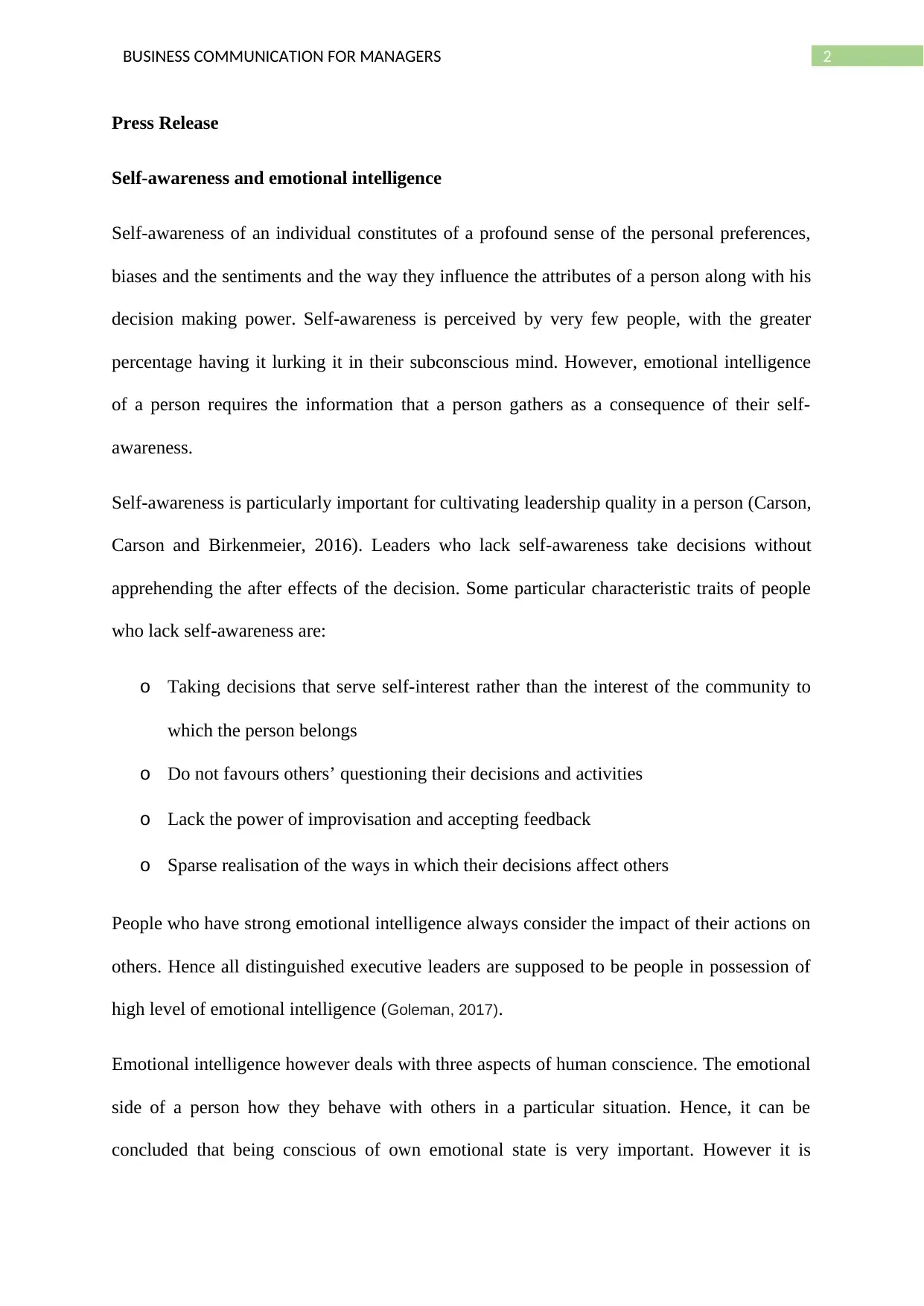
2BUSINESS COMMUNICATION FOR MANAGERS
Press Release
Self-awareness and emotional intelligence
Self-awareness of an individual constitutes of a profound sense of the personal preferences,
biases and the sentiments and the way they influence the attributes of a person along with his
decision making power. Self-awareness is perceived by very few people, with the greater
percentage having it lurking it in their subconscious mind. However, emotional intelligence
of a person requires the information that a person gathers as a consequence of their self-
awareness.
Self-awareness is particularly important for cultivating leadership quality in a person (Carson,
Carson and Birkenmeier, 2016). Leaders who lack self-awareness take decisions without
apprehending the after effects of the decision. Some particular characteristic traits of people
who lack self-awareness are:
o Taking decisions that serve self-interest rather than the interest of the community to
which the person belongs
o Do not favours others’ questioning their decisions and activities
o Lack the power of improvisation and accepting feedback
o Sparse realisation of the ways in which their decisions affect others
People who have strong emotional intelligence always consider the impact of their actions on
others. Hence all distinguished executive leaders are supposed to be people in possession of
high level of emotional intelligence (Goleman, 2017).
Emotional intelligence however deals with three aspects of human conscience. The emotional
side of a person how they behave with others in a particular situation. Hence, it can be
concluded that being conscious of own emotional state is very important. However it is
Press Release
Self-awareness and emotional intelligence
Self-awareness of an individual constitutes of a profound sense of the personal preferences,
biases and the sentiments and the way they influence the attributes of a person along with his
decision making power. Self-awareness is perceived by very few people, with the greater
percentage having it lurking it in their subconscious mind. However, emotional intelligence
of a person requires the information that a person gathers as a consequence of their self-
awareness.
Self-awareness is particularly important for cultivating leadership quality in a person (Carson,
Carson and Birkenmeier, 2016). Leaders who lack self-awareness take decisions without
apprehending the after effects of the decision. Some particular characteristic traits of people
who lack self-awareness are:
o Taking decisions that serve self-interest rather than the interest of the community to
which the person belongs
o Do not favours others’ questioning their decisions and activities
o Lack the power of improvisation and accepting feedback
o Sparse realisation of the ways in which their decisions affect others
People who have strong emotional intelligence always consider the impact of their actions on
others. Hence all distinguished executive leaders are supposed to be people in possession of
high level of emotional intelligence (Goleman, 2017).
Emotional intelligence however deals with three aspects of human conscience. The emotional
side of a person how they behave with others in a particular situation. Hence, it can be
concluded that being conscious of own emotional state is very important. However it is
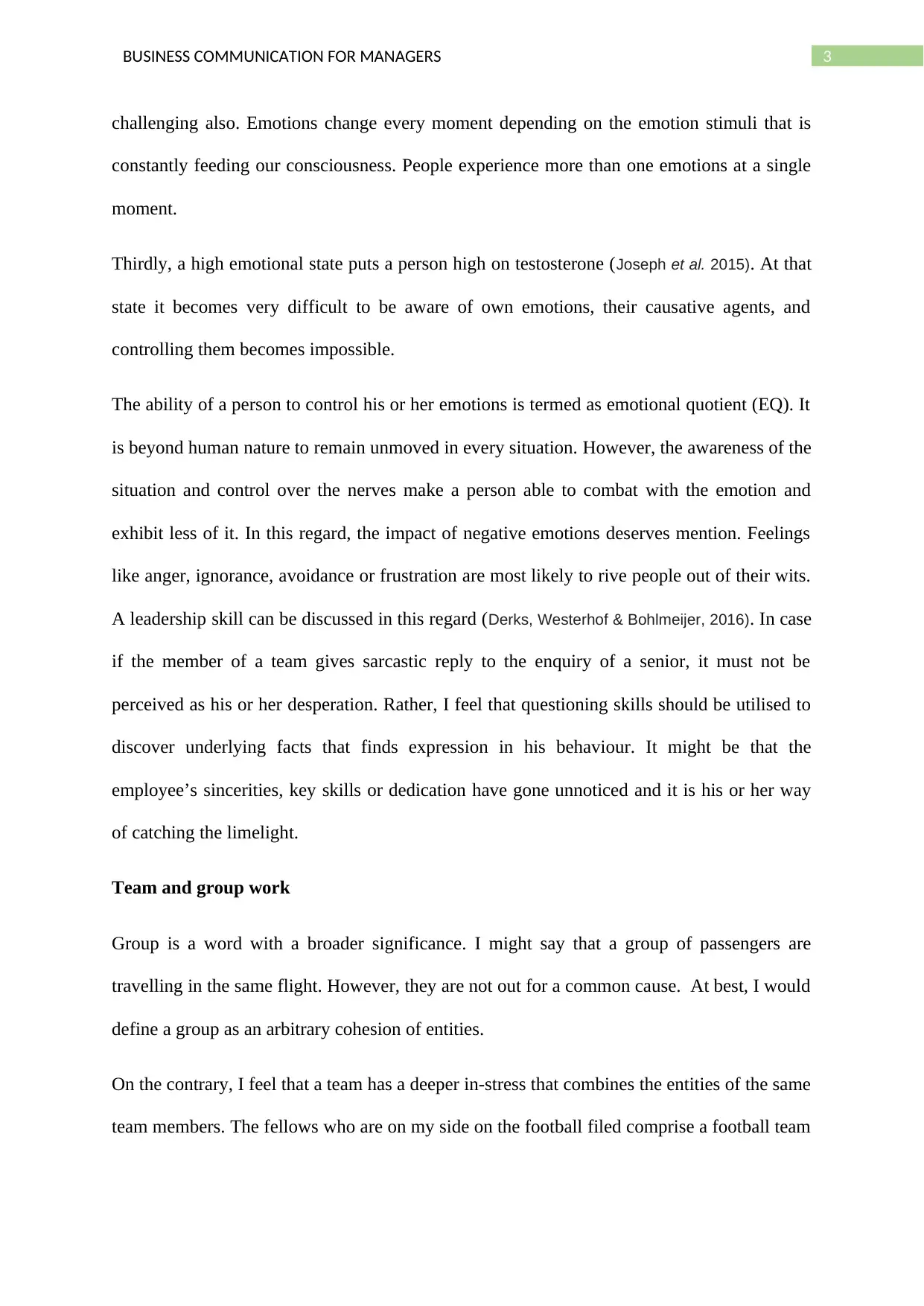
3BUSINESS COMMUNICATION FOR MANAGERS
challenging also. Emotions change every moment depending on the emotion stimuli that is
constantly feeding our consciousness. People experience more than one emotions at a single
moment.
Thirdly, a high emotional state puts a person high on testosterone (Joseph et al. 2015). At that
state it becomes very difficult to be aware of own emotions, their causative agents, and
controlling them becomes impossible.
The ability of a person to control his or her emotions is termed as emotional quotient (EQ). It
is beyond human nature to remain unmoved in every situation. However, the awareness of the
situation and control over the nerves make a person able to combat with the emotion and
exhibit less of it. In this regard, the impact of negative emotions deserves mention. Feelings
like anger, ignorance, avoidance or frustration are most likely to rive people out of their wits.
A leadership skill can be discussed in this regard (Derks, Westerhof & Bohlmeijer, 2016). In case
if the member of a team gives sarcastic reply to the enquiry of a senior, it must not be
perceived as his or her desperation. Rather, I feel that questioning skills should be utilised to
discover underlying facts that finds expression in his behaviour. It might be that the
employee’s sincerities, key skills or dedication have gone unnoticed and it is his or her way
of catching the limelight.
Team and group work
Group is a word with a broader significance. I might say that a group of passengers are
travelling in the same flight. However, they are not out for a common cause. At best, I would
define a group as an arbitrary cohesion of entities.
On the contrary, I feel that a team has a deeper in-stress that combines the entities of the same
team members. The fellows who are on my side on the football filed comprise a football team
challenging also. Emotions change every moment depending on the emotion stimuli that is
constantly feeding our consciousness. People experience more than one emotions at a single
moment.
Thirdly, a high emotional state puts a person high on testosterone (Joseph et al. 2015). At that
state it becomes very difficult to be aware of own emotions, their causative agents, and
controlling them becomes impossible.
The ability of a person to control his or her emotions is termed as emotional quotient (EQ). It
is beyond human nature to remain unmoved in every situation. However, the awareness of the
situation and control over the nerves make a person able to combat with the emotion and
exhibit less of it. In this regard, the impact of negative emotions deserves mention. Feelings
like anger, ignorance, avoidance or frustration are most likely to rive people out of their wits.
A leadership skill can be discussed in this regard (Derks, Westerhof & Bohlmeijer, 2016). In case
if the member of a team gives sarcastic reply to the enquiry of a senior, it must not be
perceived as his or her desperation. Rather, I feel that questioning skills should be utilised to
discover underlying facts that finds expression in his behaviour. It might be that the
employee’s sincerities, key skills or dedication have gone unnoticed and it is his or her way
of catching the limelight.
Team and group work
Group is a word with a broader significance. I might say that a group of passengers are
travelling in the same flight. However, they are not out for a common cause. At best, I would
define a group as an arbitrary cohesion of entities.
On the contrary, I feel that a team has a deeper in-stress that combines the entities of the same
team members. The fellows who are on my side on the football filed comprise a football team
⊘ This is a preview!⊘
Do you want full access?
Subscribe today to unlock all pages.

Trusted by 1+ million students worldwide
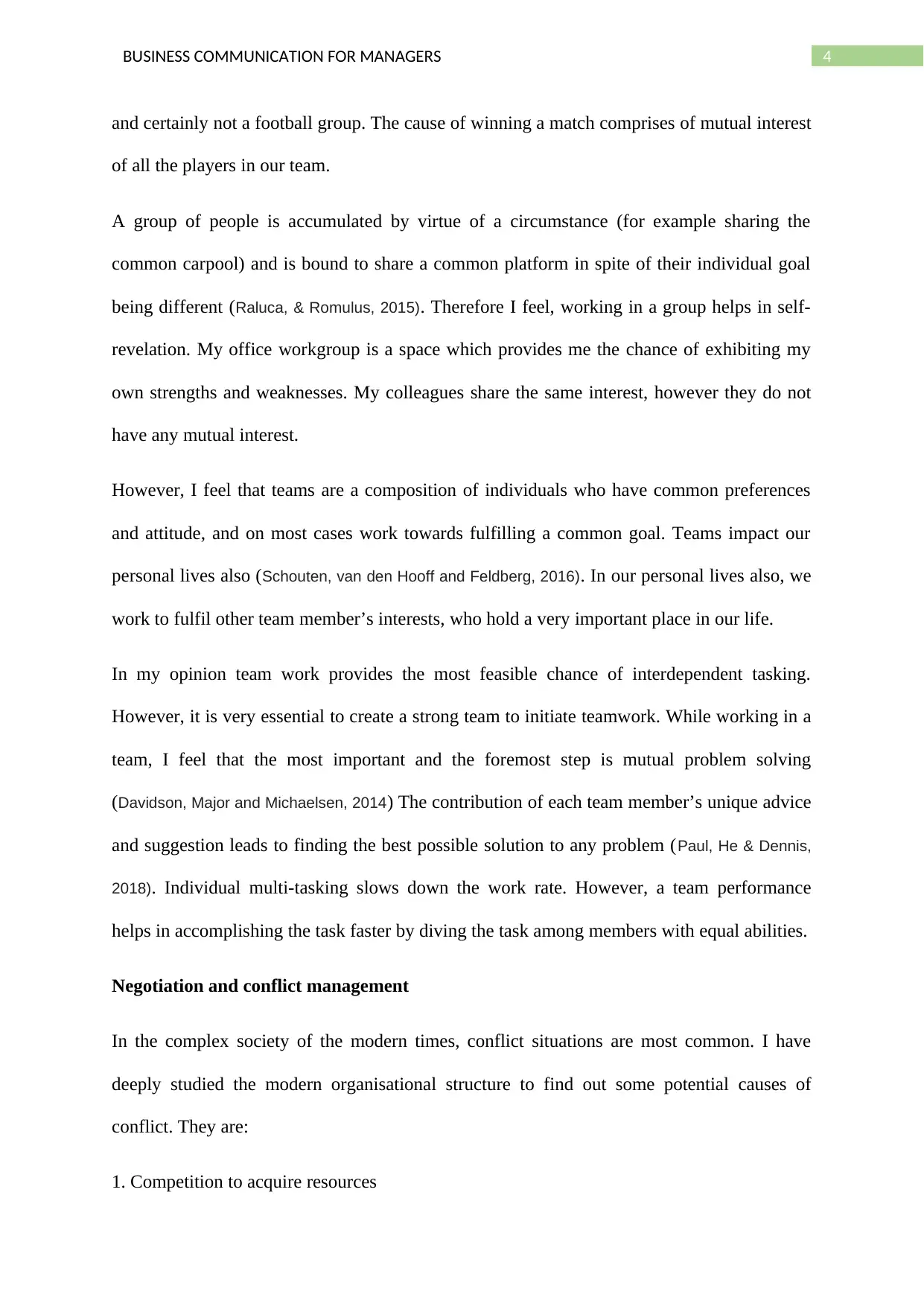
4BUSINESS COMMUNICATION FOR MANAGERS
and certainly not a football group. The cause of winning a match comprises of mutual interest
of all the players in our team.
A group of people is accumulated by virtue of a circumstance (for example sharing the
common carpool) and is bound to share a common platform in spite of their individual goal
being different (Raluca, & Romulus, 2015). Therefore I feel, working in a group helps in self-
revelation. My office workgroup is a space which provides me the chance of exhibiting my
own strengths and weaknesses. My colleagues share the same interest, however they do not
have any mutual interest.
However, I feel that teams are a composition of individuals who have common preferences
and attitude, and on most cases work towards fulfilling a common goal. Teams impact our
personal lives also (Schouten, van den Hooff and Feldberg, 2016). In our personal lives also, we
work to fulfil other team member’s interests, who hold a very important place in our life.
In my opinion team work provides the most feasible chance of interdependent tasking.
However, it is very essential to create a strong team to initiate teamwork. While working in a
team, I feel that the most important and the foremost step is mutual problem solving
(Davidson, Major and Michaelsen, 2014) The contribution of each team member’s unique advice
and suggestion leads to finding the best possible solution to any problem (Paul, He & Dennis,
2018). Individual multi-tasking slows down the work rate. However, a team performance
helps in accomplishing the task faster by diving the task among members with equal abilities.
Negotiation and conflict management
In the complex society of the modern times, conflict situations are most common. I have
deeply studied the modern organisational structure to find out some potential causes of
conflict. They are:
1. Competition to acquire resources
and certainly not a football group. The cause of winning a match comprises of mutual interest
of all the players in our team.
A group of people is accumulated by virtue of a circumstance (for example sharing the
common carpool) and is bound to share a common platform in spite of their individual goal
being different (Raluca, & Romulus, 2015). Therefore I feel, working in a group helps in self-
revelation. My office workgroup is a space which provides me the chance of exhibiting my
own strengths and weaknesses. My colleagues share the same interest, however they do not
have any mutual interest.
However, I feel that teams are a composition of individuals who have common preferences
and attitude, and on most cases work towards fulfilling a common goal. Teams impact our
personal lives also (Schouten, van den Hooff and Feldberg, 2016). In our personal lives also, we
work to fulfil other team member’s interests, who hold a very important place in our life.
In my opinion team work provides the most feasible chance of interdependent tasking.
However, it is very essential to create a strong team to initiate teamwork. While working in a
team, I feel that the most important and the foremost step is mutual problem solving
(Davidson, Major and Michaelsen, 2014) The contribution of each team member’s unique advice
and suggestion leads to finding the best possible solution to any problem (Paul, He & Dennis,
2018). Individual multi-tasking slows down the work rate. However, a team performance
helps in accomplishing the task faster by diving the task among members with equal abilities.
Negotiation and conflict management
In the complex society of the modern times, conflict situations are most common. I have
deeply studied the modern organisational structure to find out some potential causes of
conflict. They are:
1. Competition to acquire resources
Paraphrase This Document
Need a fresh take? Get an instant paraphrase of this document with our AI Paraphraser
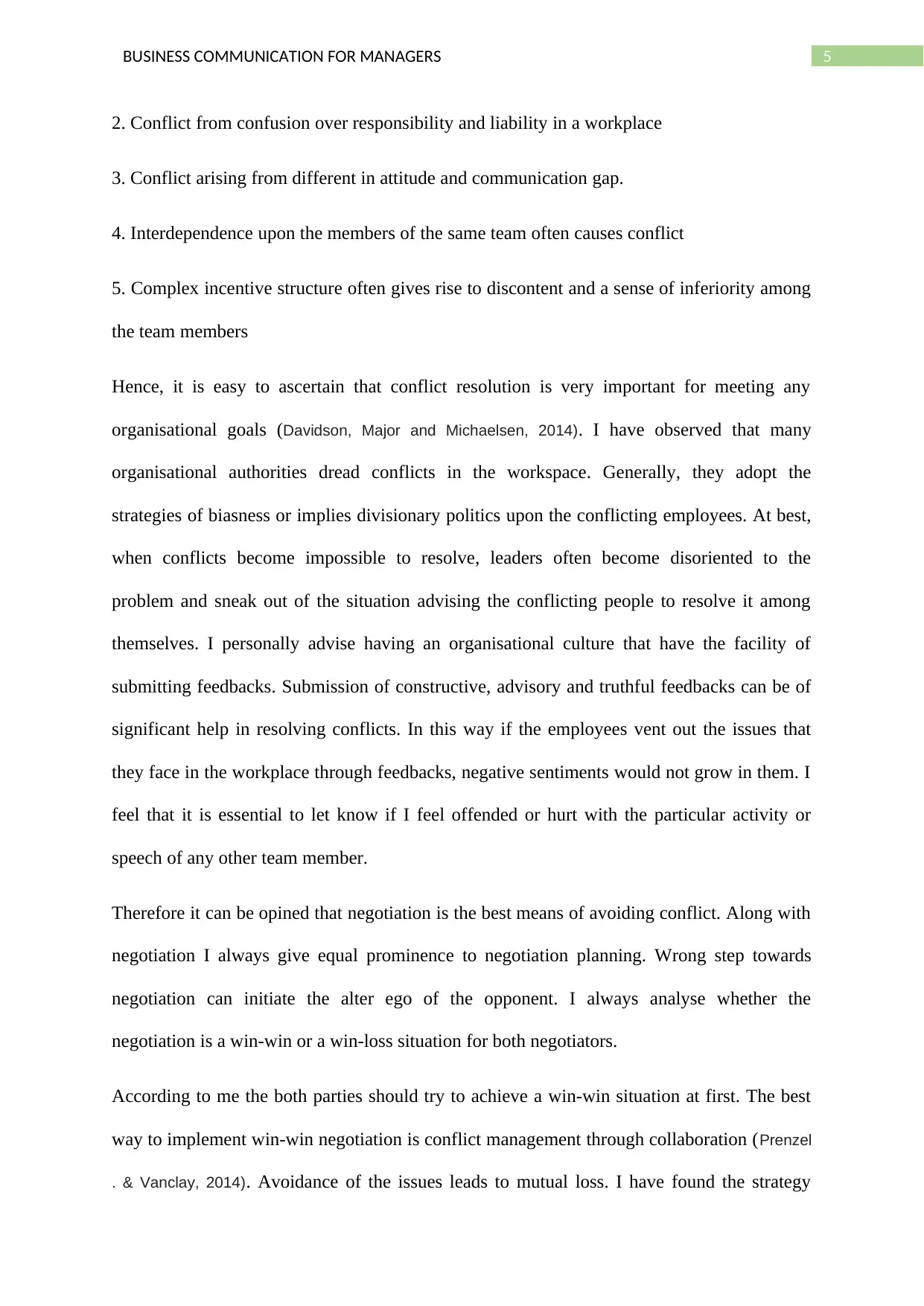
5BUSINESS COMMUNICATION FOR MANAGERS
2. Conflict from confusion over responsibility and liability in a workplace
3. Conflict arising from different in attitude and communication gap.
4. Interdependence upon the members of the same team often causes conflict
5. Complex incentive structure often gives rise to discontent and a sense of inferiority among
the team members
Hence, it is easy to ascertain that conflict resolution is very important for meeting any
organisational goals (Davidson, Major and Michaelsen, 2014). I have observed that many
organisational authorities dread conflicts in the workspace. Generally, they adopt the
strategies of biasness or implies divisionary politics upon the conflicting employees. At best,
when conflicts become impossible to resolve, leaders often become disoriented to the
problem and sneak out of the situation advising the conflicting people to resolve it among
themselves. I personally advise having an organisational culture that have the facility of
submitting feedbacks. Submission of constructive, advisory and truthful feedbacks can be of
significant help in resolving conflicts. In this way if the employees vent out the issues that
they face in the workplace through feedbacks, negative sentiments would not grow in them. I
feel that it is essential to let know if I feel offended or hurt with the particular activity or
speech of any other team member.
Therefore it can be opined that negotiation is the best means of avoiding conflict. Along with
negotiation I always give equal prominence to negotiation planning. Wrong step towards
negotiation can initiate the alter ego of the opponent. I always analyse whether the
negotiation is a win-win or a win-loss situation for both negotiators.
According to me the both parties should try to achieve a win-win situation at first. The best
way to implement win-win negotiation is conflict management through collaboration (Prenzel
. & Vanclay, 2014). Avoidance of the issues leads to mutual loss. I have found the strategy
2. Conflict from confusion over responsibility and liability in a workplace
3. Conflict arising from different in attitude and communication gap.
4. Interdependence upon the members of the same team often causes conflict
5. Complex incentive structure often gives rise to discontent and a sense of inferiority among
the team members
Hence, it is easy to ascertain that conflict resolution is very important for meeting any
organisational goals (Davidson, Major and Michaelsen, 2014). I have observed that many
organisational authorities dread conflicts in the workspace. Generally, they adopt the
strategies of biasness or implies divisionary politics upon the conflicting employees. At best,
when conflicts become impossible to resolve, leaders often become disoriented to the
problem and sneak out of the situation advising the conflicting people to resolve it among
themselves. I personally advise having an organisational culture that have the facility of
submitting feedbacks. Submission of constructive, advisory and truthful feedbacks can be of
significant help in resolving conflicts. In this way if the employees vent out the issues that
they face in the workplace through feedbacks, negative sentiments would not grow in them. I
feel that it is essential to let know if I feel offended or hurt with the particular activity or
speech of any other team member.
Therefore it can be opined that negotiation is the best means of avoiding conflict. Along with
negotiation I always give equal prominence to negotiation planning. Wrong step towards
negotiation can initiate the alter ego of the opponent. I always analyse whether the
negotiation is a win-win or a win-loss situation for both negotiators.
According to me the both parties should try to achieve a win-win situation at first. The best
way to implement win-win negotiation is conflict management through collaboration (Prenzel
. & Vanclay, 2014). Avoidance of the issues leads to mutual loss. I have found the strategy
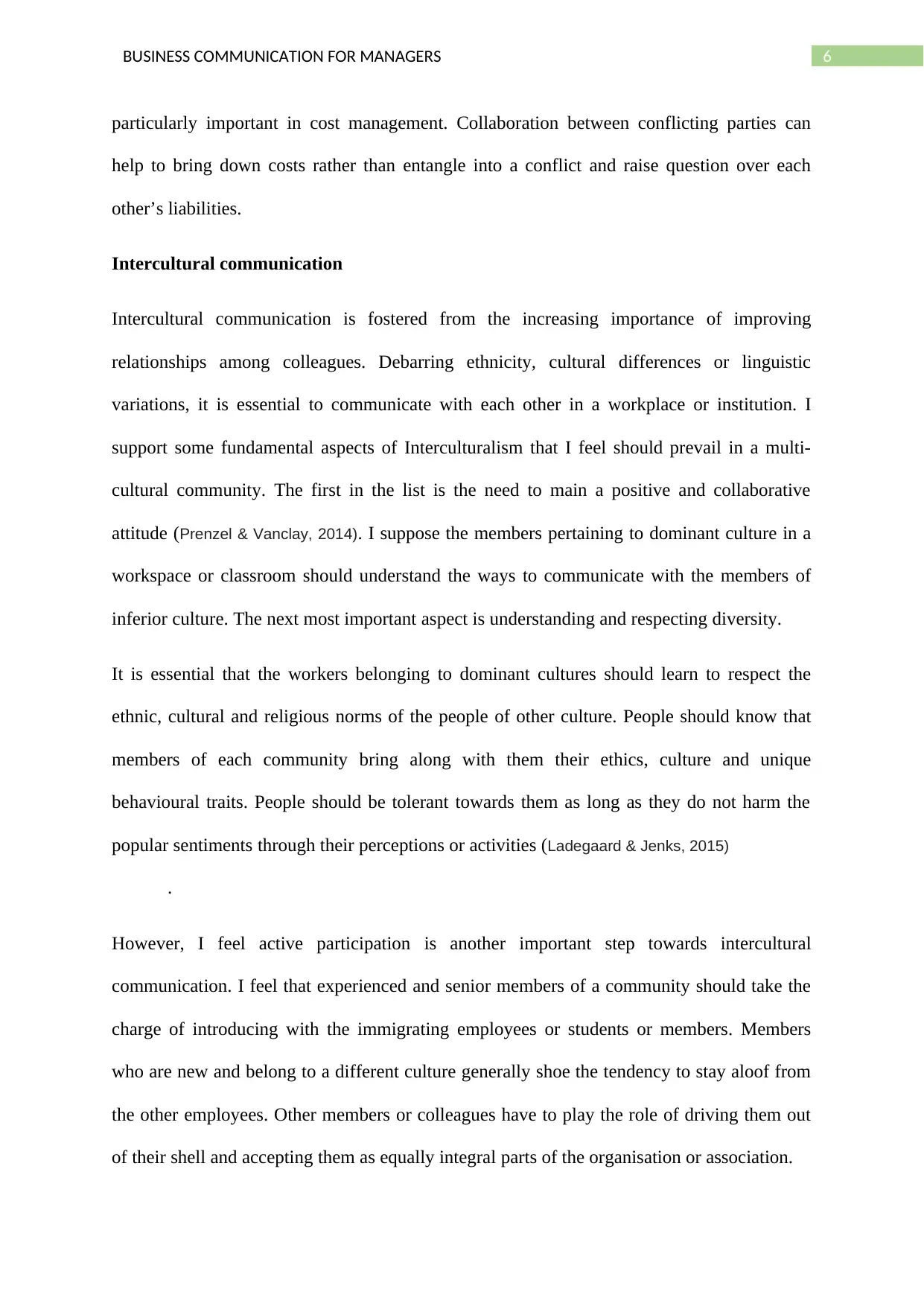
6BUSINESS COMMUNICATION FOR MANAGERS
particularly important in cost management. Collaboration between conflicting parties can
help to bring down costs rather than entangle into a conflict and raise question over each
other’s liabilities.
Intercultural communication
Intercultural communication is fostered from the increasing importance of improving
relationships among colleagues. Debarring ethnicity, cultural differences or linguistic
variations, it is essential to communicate with each other in a workplace or institution. I
support some fundamental aspects of Interculturalism that I feel should prevail in a multi-
cultural community. The first in the list is the need to main a positive and collaborative
attitude (Prenzel & Vanclay, 2014). I suppose the members pertaining to dominant culture in a
workspace or classroom should understand the ways to communicate with the members of
inferior culture. The next most important aspect is understanding and respecting diversity.
It is essential that the workers belonging to dominant cultures should learn to respect the
ethnic, cultural and religious norms of the people of other culture. People should know that
members of each community bring along with them their ethics, culture and unique
behavioural traits. People should be tolerant towards them as long as they do not harm the
popular sentiments through their perceptions or activities (Ladegaard & Jenks, 2015)
.
However, I feel active participation is another important step towards intercultural
communication. I feel that experienced and senior members of a community should take the
charge of introducing with the immigrating employees or students or members. Members
who are new and belong to a different culture generally shoe the tendency to stay aloof from
the other employees. Other members or colleagues have to play the role of driving them out
of their shell and accepting them as equally integral parts of the organisation or association.
particularly important in cost management. Collaboration between conflicting parties can
help to bring down costs rather than entangle into a conflict and raise question over each
other’s liabilities.
Intercultural communication
Intercultural communication is fostered from the increasing importance of improving
relationships among colleagues. Debarring ethnicity, cultural differences or linguistic
variations, it is essential to communicate with each other in a workplace or institution. I
support some fundamental aspects of Interculturalism that I feel should prevail in a multi-
cultural community. The first in the list is the need to main a positive and collaborative
attitude (Prenzel & Vanclay, 2014). I suppose the members pertaining to dominant culture in a
workspace or classroom should understand the ways to communicate with the members of
inferior culture. The next most important aspect is understanding and respecting diversity.
It is essential that the workers belonging to dominant cultures should learn to respect the
ethnic, cultural and religious norms of the people of other culture. People should know that
members of each community bring along with them their ethics, culture and unique
behavioural traits. People should be tolerant towards them as long as they do not harm the
popular sentiments through their perceptions or activities (Ladegaard & Jenks, 2015)
.
However, I feel active participation is another important step towards intercultural
communication. I feel that experienced and senior members of a community should take the
charge of introducing with the immigrating employees or students or members. Members
who are new and belong to a different culture generally shoe the tendency to stay aloof from
the other employees. Other members or colleagues have to play the role of driving them out
of their shell and accepting them as equally integral parts of the organisation or association.
⊘ This is a preview!⊘
Do you want full access?
Subscribe today to unlock all pages.

Trusted by 1+ million students worldwide

7BUSINESS COMMUNICATION FOR MANAGERS
The last thing that people should remember in an environment of mixed culture is that they
should avoid racism and discriminatory policies. Every organisation or institution should
have their own anti-discriminatory policies. This would discourage the associated people
from engaging racism and conduct discriminatory behaviour with others.
The last thing that people should remember in an environment of mixed culture is that they
should avoid racism and discriminatory policies. Every organisation or institution should
have their own anti-discriminatory policies. This would discourage the associated people
from engaging racism and conduct discriminatory behaviour with others.
Paraphrase This Document
Need a fresh take? Get an instant paraphrase of this document with our AI Paraphraser
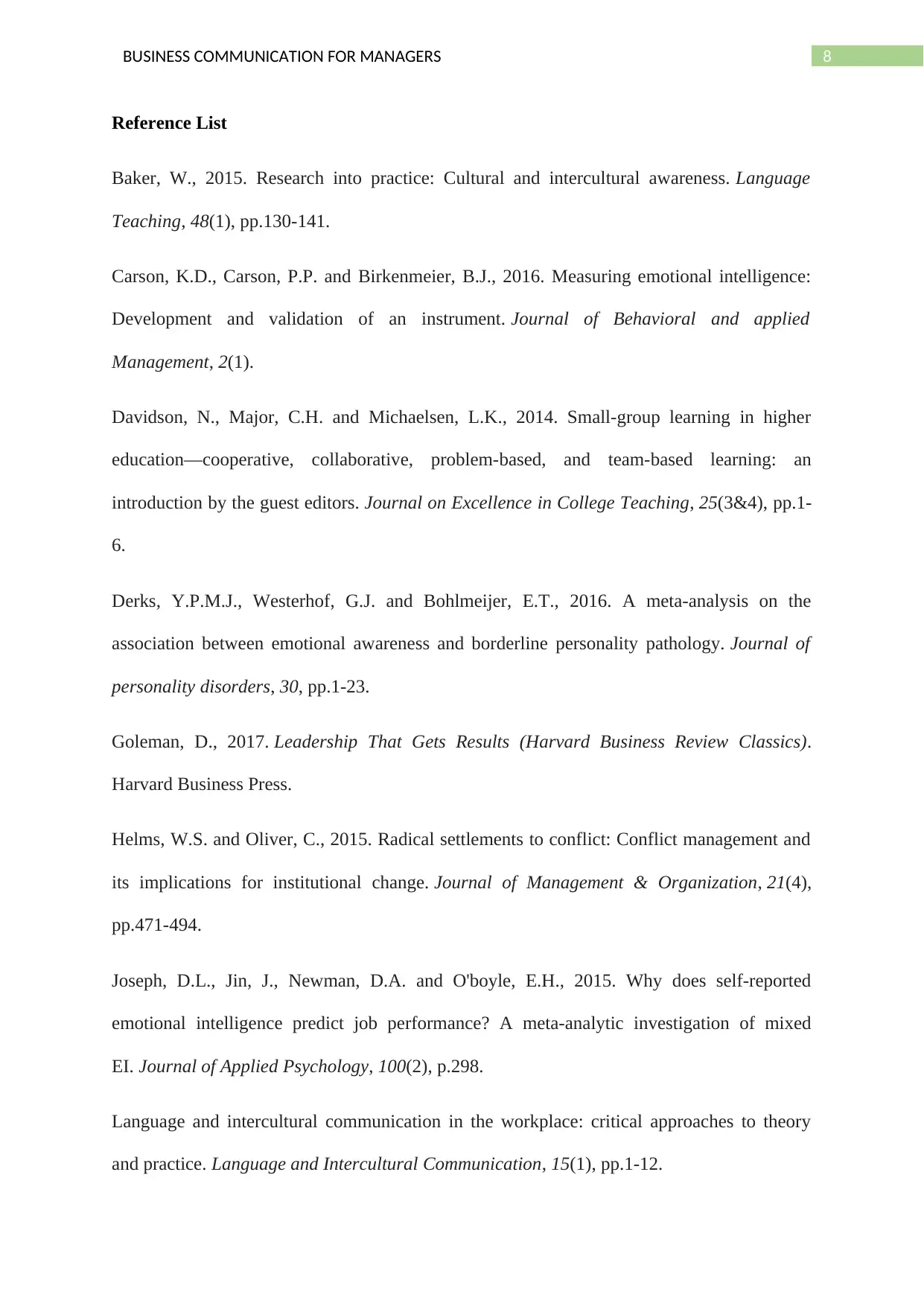
8BUSINESS COMMUNICATION FOR MANAGERS
Reference List
Baker, W., 2015. Research into practice: Cultural and intercultural awareness. Language
Teaching, 48(1), pp.130-141.
Carson, K.D., Carson, P.P. and Birkenmeier, B.J., 2016. Measuring emotional intelligence:
Development and validation of an instrument. Journal of Behavioral and applied
Management, 2(1).
Davidson, N., Major, C.H. and Michaelsen, L.K., 2014. Small-group learning in higher
education—cooperative, collaborative, problem-based, and team-based learning: an
introduction by the guest editors. Journal on Excellence in College Teaching, 25(3&4), pp.1-
6.
Derks, Y.P.M.J., Westerhof, G.J. and Bohlmeijer, E.T., 2016. A meta-analysis on the
association between emotional awareness and borderline personality pathology. Journal of
personality disorders, 30, pp.1-23.
Goleman, D., 2017. Leadership That Gets Results (Harvard Business Review Classics).
Harvard Business Press.
Helms, W.S. and Oliver, C., 2015. Radical settlements to conflict: Conflict management and
its implications for institutional change. Journal of Management & Organization, 21(4),
pp.471-494.
Joseph, D.L., Jin, J., Newman, D.A. and O'boyle, E.H., 2015. Why does self-reported
emotional intelligence predict job performance? A meta-analytic investigation of mixed
EI. Journal of Applied Psychology, 100(2), p.298.
Language and intercultural communication in the workplace: critical approaches to theory
and practice. Language and Intercultural Communication, 15(1), pp.1-12.
Reference List
Baker, W., 2015. Research into practice: Cultural and intercultural awareness. Language
Teaching, 48(1), pp.130-141.
Carson, K.D., Carson, P.P. and Birkenmeier, B.J., 2016. Measuring emotional intelligence:
Development and validation of an instrument. Journal of Behavioral and applied
Management, 2(1).
Davidson, N., Major, C.H. and Michaelsen, L.K., 2014. Small-group learning in higher
education—cooperative, collaborative, problem-based, and team-based learning: an
introduction by the guest editors. Journal on Excellence in College Teaching, 25(3&4), pp.1-
6.
Derks, Y.P.M.J., Westerhof, G.J. and Bohlmeijer, E.T., 2016. A meta-analysis on the
association between emotional awareness and borderline personality pathology. Journal of
personality disorders, 30, pp.1-23.
Goleman, D., 2017. Leadership That Gets Results (Harvard Business Review Classics).
Harvard Business Press.
Helms, W.S. and Oliver, C., 2015. Radical settlements to conflict: Conflict management and
its implications for institutional change. Journal of Management & Organization, 21(4),
pp.471-494.
Joseph, D.L., Jin, J., Newman, D.A. and O'boyle, E.H., 2015. Why does self-reported
emotional intelligence predict job performance? A meta-analytic investigation of mixed
EI. Journal of Applied Psychology, 100(2), p.298.
Language and intercultural communication in the workplace: critical approaches to theory
and practice. Language and Intercultural Communication, 15(1), pp.1-12.
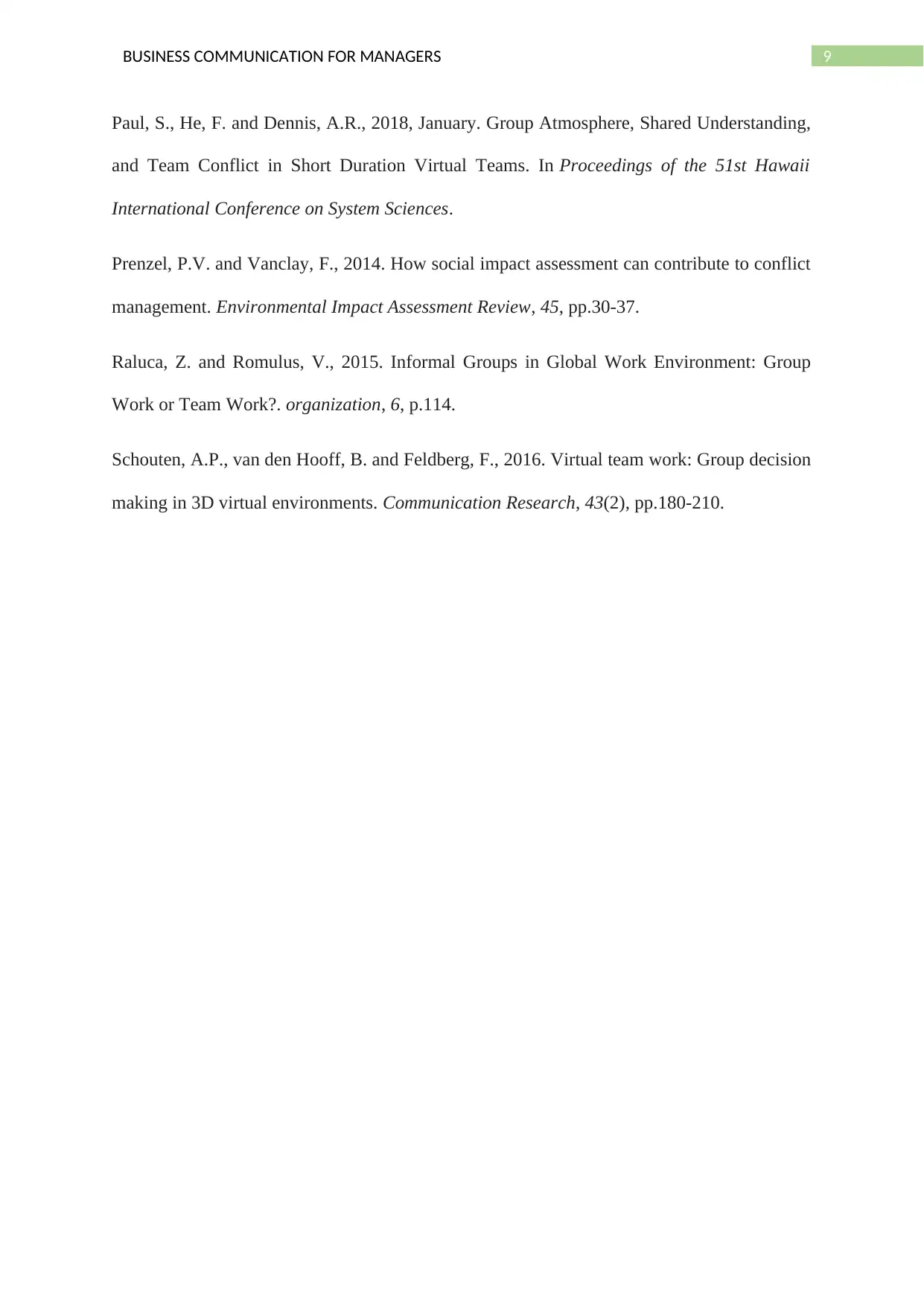
9BUSINESS COMMUNICATION FOR MANAGERS
Paul, S., He, F. and Dennis, A.R., 2018, January. Group Atmosphere, Shared Understanding,
and Team Conflict in Short Duration Virtual Teams. In Proceedings of the 51st Hawaii
International Conference on System Sciences.
Prenzel, P.V. and Vanclay, F., 2014. How social impact assessment can contribute to conflict
management. Environmental Impact Assessment Review, 45, pp.30-37.
Raluca, Z. and Romulus, V., 2015. Informal Groups in Global Work Environment: Group
Work or Team Work?. organization, 6, p.114.
Schouten, A.P., van den Hooff, B. and Feldberg, F., 2016. Virtual team work: Group decision
making in 3D virtual environments. Communication Research, 43(2), pp.180-210.
Paul, S., He, F. and Dennis, A.R., 2018, January. Group Atmosphere, Shared Understanding,
and Team Conflict in Short Duration Virtual Teams. In Proceedings of the 51st Hawaii
International Conference on System Sciences.
Prenzel, P.V. and Vanclay, F., 2014. How social impact assessment can contribute to conflict
management. Environmental Impact Assessment Review, 45, pp.30-37.
Raluca, Z. and Romulus, V., 2015. Informal Groups in Global Work Environment: Group
Work or Team Work?. organization, 6, p.114.
Schouten, A.P., van den Hooff, B. and Feldberg, F., 2016. Virtual team work: Group decision
making in 3D virtual environments. Communication Research, 43(2), pp.180-210.
⊘ This is a preview!⊘
Do you want full access?
Subscribe today to unlock all pages.

Trusted by 1+ million students worldwide
1 out of 9
Related Documents
Your All-in-One AI-Powered Toolkit for Academic Success.
+13062052269
info@desklib.com
Available 24*7 on WhatsApp / Email
![[object Object]](/_next/static/media/star-bottom.7253800d.svg)
Unlock your academic potential
Copyright © 2020–2025 A2Z Services. All Rights Reserved. Developed and managed by ZUCOL.





